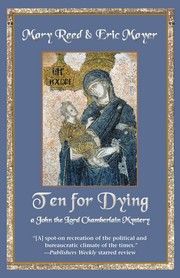


1482155 Curiosities served
June Reading
Previous Entry :: Next Entry
Read/Post Comments (14)
The Girl in the Glass -- Jeffrey Ford (2005)
In depression-era New York, three con artists find themselves in trouble when they try to solve the mysterious disappearance of a young girl. The brilliantly devious leader Schell, his informally adopted son Diego -- an illegal Mexican immigrant -- and Antony Cleopatra, a former carny strongman, specialize in bilking wealthy Long Islanders at fake seances. But during one performance, Schell glimpses a child's ghostly image in a the glass pane of a door and decides to investigate. The reviews I read after finishing the book, give away far too much about the historically accurate mess the men stumble into,, so I won't. I will say I loved this story, which reminded me of Fredric Brown's classic, The Fabulous Clip Joint, perhaps partly because, like the Brown book it is told from the point of view of the almost grown-up protege of a flimflam man, and there is a distinct carny connection. Although Jeffrey Ford is best known for his fantasies, The Girl in the Glass won a well deserved Edgar award for best original paperback mystery.
Christian Topography -- Cosmas Indicopleustes (535--547)
Written during the reign of Justinian by a commercial traveler turned monk, this peculiar text sets forth the proposition that the world/universe is -- as revealed by the Bible -- shaped like the tabernacle Moses was instructed to erect in the desert. I have read it before but it was worth perusing again -- a classic of eccentric reasoning. Cosmas delights in making fun of the wrongheaded pagans who believed the earth to be a sphere. Knowing neither ancient Greek nor Latin I can't help wondering exactly what was the term he used repeatedly which has been ultimately rendered into English as "wiseacres."
The Body Snatchers -- Jack Finney (1955)
The famous creepy tale of aliens who descend upon the earth and emerge from pods to take over human bodies. There's something chilling about things that aren't what they seem, especially common things, like the people around us. Once we have reason to doubt our own senses and our rational interpretation of the world, we're in big trouble. The premise is science fictional but the novel is more a thriller. Damon Knight criticized its lack of scientific accuracy, which goes to show how wrongheaded critics can be when they insist on forcing genre rules on books that don't care about fitting into genres.
Tales of Terror From the Tunnel's Mouth -- Chris Priestley (2009)
While a train is inexplicably stopped at the entrance to a tunnel, a lady in white tells a boy off to his new school a series of supernatural tales about young people coming to macabre ends. The Gorey-like illustrations capture the style and mood perfectly. The interplay between the storyteller and the would-be worldly boy -- a typical Victorian teen one assumes from his attitude -- makes the book more than just a collection of stories.
The Cold Kiss-- John Rector (2010)
A down and out young couple headed for Reno give a ride to a dying man who turns out to be carrying a backpack stuffed with money. A snowstorm strands them all at a nearly deserted motel. What could possibly go wrong? A brilliant noir novel in the old fifties Gold Medal tradition. To say more would risk ruining it. I will note that the ending is a twist beyond the usual cliched twist.
Double Indemnity -- James M. Cain (1936)
A crooked insurance salesman is seduced into helping a woman kill her husband for a big insurance payout. Starkly written, the book has aura of gritty realism, even though the whole scheme is nonsense when you stop to think about it. One feature of these old noir novels I like is that there's no time wasted on justifying relationships. The instant the guy sets eyes on the girl he's ready to kill for her. Which might actually make these stories more true to life than your typical modern novel.
The Killer Inside Me -- Jim Thompson (1952)
Deputy Sheriff Lou Ford, who tells his own story, is one sick puppy. And he knows it. He constantly analyzes himself. Which doesn't stop him from killing, again and again to cover his tracks. This is a book that disproves the canard about the necessity for a sympathetic protagonist. If you're not hoping that Ford gets caught, there's probably something wrong with you. But it's a compelling novel nevertheless. Without over-the-top gore or language, Thompson wrote one of the most disturbing, and repulsive, depictions of the criminal mind you're likely to read.
Neon Angel: A Memoir of a Runaway --Cherie Currie and Tony O'Neil (2010)
After the horrifying The Killer Inside Me, I decided to read something "lighter." Oops. Cherie Currie's autobiographical account of her meteoric career with the Runaways all-girl rock band from the seventies is as harrowing as Jim Thompson's noir classic, features a lot of the same kind of violence, and is also true. In less than a decade Cherie goes from fifteen-year old high school misfit, to recording and movie star, to burnt-out drug addict.
Fascinating behind the scenes look at rock n' roll life during an era when I followed the music. Today the "Cherry Bomb" sculpts wood with a chain saw. Go figure.
Read/Post Comments (14)
Previous Entry :: Next Entry
Back to Top

